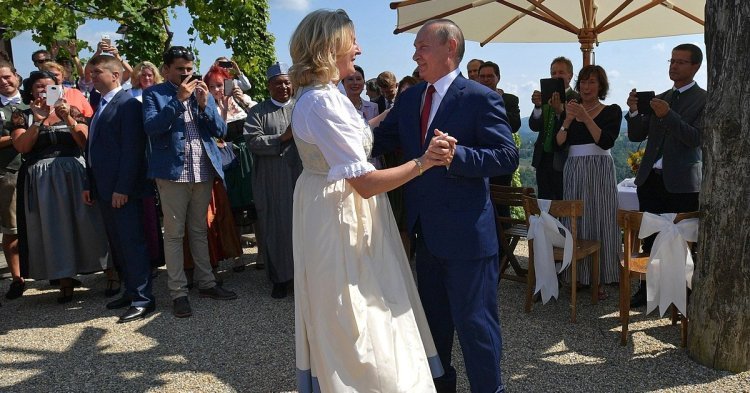2014: when the EU left Russia “on read”
It’s safe to say that everyone in Europe knows Putin’s name, even the people who show no interest in politics at all, and even if they know that he’s a “bad man”, one of these people that our parents warned us about. However, it wasn’t always like this, at least in the eyes of Western diplomacy.
In 2007, the newly elected French President, Nicolas Sarkozy, drank vodka with Putin. The first Obama administration proclaimed the so-called “reset” in its relations with Russia. Putin was making deals in Europe, occasionally meeting with Angela Merkel and scaring her with dogs (she’s believed to suffer from cynophobia, fear of dogs). In 2012, the first Nord Stream pipeline was inaugurated, which allowed Russia to send gas to Western Europe, bypassing the traditionally Russosceptic, if not Russophobe, Eastern European states. The Nord Stream 2 was on its way, but the European party got cancelled. What went wrong?
The European Union has tried to expand its sphere of influence. Accepting the NATO and the EU enlargements to the former communist countries was a hard pill to swallow. But trying to bring Ukraine closer to the EU was one step too far. In 2013, Ukraine was about to sign the Association Agreement with the EU, when suddenly Ukrainian President Viktor Yanukovych chose not to sign it and decided to proceed with Ukraine’s integration towards Russian-led Eurasian Economic Union. This decision sparked the pro-European protests which eventually removed Yanukovych from power and made him flee the country. That’s when Putin made up his mind about the annexation of Crimea. And so he did in 2014.
Russia banned from European salons?
The annexation of Crimea and Russia’s involvement in the conflict in Eastern Ukraine were the reasons behind the EU imposing sanctions on Russia in March 2014. However, the European leaders’ approach toward sanctions is a bit of a complicated issue. It’s like going to the gym – nobody likes it, but everyone does it to look good.
The EU’s sanctions were also a means to look good. Russia-targeted sanctions and the countersanctions imposed on the EU severely harmed the economies of both sides. The Polish apples could no longer be sold to Russia, the French wine was no longer drunk by Moscow intellectuals. The G8, group uniting the eight most powerful world economies, including Russia, now became G7. The consensus was that until Russia stops occupying Crimea and its troops leave the Ukrainian territory, it will be boycotted on the international fora.
Although the EU has been unanimous in imposing sanctions on Russia and renewing them every 6 months, some European leaders publicly expressed their discontent. And it turned out that Vladimir Putin actually has some friends in Europe.
The Hungarian Prime Minister, Viktor Orbán, described imposing sanctions against Russia as “shooting oneself in the foot”. Moreover, the Slovakian Prime Minister at that time, Robert Fico, admitted that sanctions “harm both the EU and Russia” and said they should be lifted. Also, French Senate adopted a non-binding resolution in June 2016, calling for lifting the sanctions. Nevertheless, despite the ambiguity in the EU’s approach towards Russia, the sanctions are still in place.
Russia keeps dancing on its own
What is surely worrying for the European Union is the fact that its unity is threatened. And 2019 is especially dangerous in that context. Not only is it the year of Brexit, but also of the European elections. Russia is known for meddling in other people’s business, as was proven by its involvement in the Brexit referendum. This year’s elections may bring a reconfiguration of power within the European Parliament. The Eurosceptic parties like the French National Rally, Polish Law and Justice or Italian League may gain considerable number of seats in the new term.
It is a well-known fact that Marine Le Pen from the National Rally is financially supported by Kremlin. Matteo Salvini, leader of the League, describes anti-Russian sanctions as “madness”. Nonetheless, the picture is not black and white. Even though Hungarian PM Viktor Orbán is Putin’s friend, he is not going to risk losing his party’s place within the European People’s Party. The leader of the Polish Law and Justice party, Jarosław Kaczyński, is openly anti-Russian.Still, every sign of growing disunity in the EU is an occasion for Putin to open another bottle of champagne.
Putin knows that no one will believe anymore in his change like many did in 2008. That’s why instead of trying to convince the old friends, he’s trying to make new ones. And if dancing at the wedding of Austrian Foreign Minister Karin Kneissl is what it takes to achieve the new goal, Putin is ready to do it.
Hope is a dangerous thing?
Although Russia has friends within the EU, it doesn’t mean that they’ll be so eager to help it. After almost five years of sanctions, both the EU and Russia have managed to make up for the loss to their economies. It seems that everyone got used to the fact that Russia is boycotted. The EU was shaken by the UK’s decisiobut n to leave, nonetheless, the shock is over and the European leaders are ready to move on. Even Marine Le Pen no longer speaks for a “Frexit”. Also, the attempt to murder the former spy Sergei Skripal, and the kidnapping of Ukrainian mariners on the Azov Sea, gave the EU an excuse not to lift the sanctions.
The EU knows that hope is a dangerous thing. But it has it.


Follow the comments: |
|
